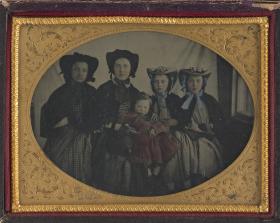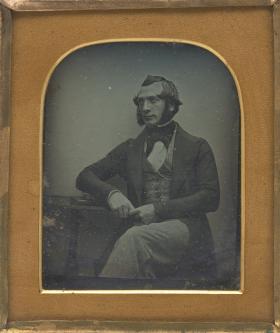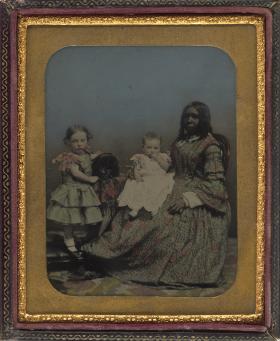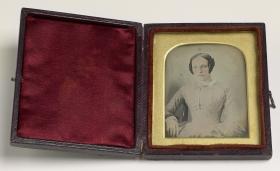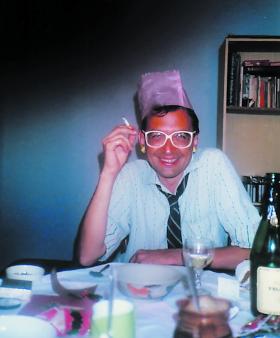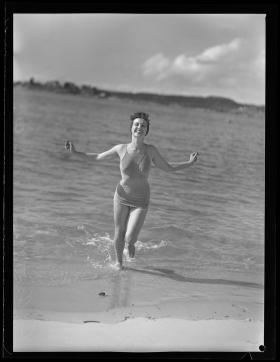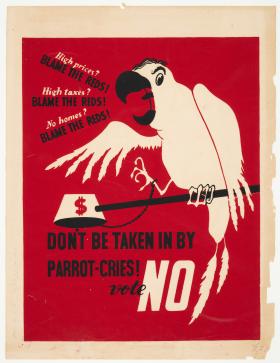When Henry Kidd Harpur arrived in Sydney in 1841, he could not have known that his logbook would be at the core of a remarkable collection donated to the Library 180 years later.
In September 1840, Henry Kidd Harpur and his younger brother, Josiah, sailed from Liverpool bound for Sydney, and a new life in the growing colony. The Harpur logbook documents the ship journey taken by so many hopeful immigrants at that time and details their first days and weeks in Sydney, and then Bathurst, as Henry does the rounds of his contacts looking for appropriate work for his younger brother and himself.
… We then did not know what to do. I could scarcely contain from crying aloud in the open street when I found myself all alone and friendless in a far, far distant, strange country where everything and every person seemed to laugh me to scorn. I now wish most heartily that I had stayed at home ...
— Thursday 11 March 1841
Traces of the lives that the Harpur brothers established in Australia were passed down through the family to Henry's great-grandson, Kenneth Richard Harpur. Every family seems to have their keeper of family history and in 1973 Ken self-published a limited edition of 25 copies of Harpur history, a transcription of Henry's logbook, along with letter fragments and associated family genealogy.
The Library was given a copy at the time and because of our remit to collect original material, tried to persuade Ken Harpur to donate the logbook itself. But it wasn’t until 2019 that Ken approached the Library again and offered us the logbook, along with other research he had done on the immigrant ship The Brothers, on which the brothers arrived.
The offer, which arrived by email, was allocated to me to process. I immediately recognised the opportunity to secure the logbook that is at the heart of the Harpur story. However, after several rounds of correspondence discussing details of the offer and how to get the material to the Library, the emails unexpectedly fell silent.
Then, in March 2022 I received a crackly voicemail message from a Gregg Harpur. Sadly, he told me, his uncle Ken had passed away, but while clearing his belongings, Gregg and wife Christine had come across my email correspondence and wondered if the Library was still interested in the Harpur material.
We arranged for them to bring it in for assessment. Here, at last, were the logbooks written by Henry Kidd Harpur on his long journey to Australia with Josiah. Here were the worn letters between the brothers, and their family in Ireland. And here were many print photographs of the descendants of the Harpur brothers. All were perfect for the Library’s collection given they document two men making new lives in Australia in the mid-nineteenth century.
But the real surprise came when the Harpurs brought my attention to a small wicker storage basket. ‘We’re not sure about these’, they said. ‘Let us know if you’re interested in them as well.’
There, sitting in the basket I saw a collection of ten ambrotype and daguerreotype photos in their distinctive red-leather cases. At first glance, I could see that they were in remarkable condition. Only after further research would their full significance be revealed.
The collection of photos included several of family members in Ireland, either brought with the Harpurs as mementos or sent to them in Australia. Six of the images, however, were taken in Australia and included an individual portrait of Henry Kidd Harpur and a portrait of his wife Henrietta Elizabeth Harpur (nee Walker).
Another particularly intriguing photo included the note ‘Old Sally (nurse) with Aunt Eliza’s children Janie & Susie’. It was an astonishing group portrait of a First Nations woman clearly in service to the family and dressed in contemporary Western clothing, with two young girls and their dog.
Using the family tree from Ken Harpur’s book and Ancestry.com, the children were quickly identified as Josiah and Eliza Harpur’s daughters Jane Henrietta Kidd Harpur (1857–1875) and Susanna Matilda Australia Harpur (1859–1873). Therefore the photo was probably taken around 1860.
A stamp on the mount of this beautiful ambrotype photo confirms that it was taken by renowned early photographer Thomas Glaister (1824–1904). But who was the First Nations woman, ‘Old Sally’, in her extraordinary dress, posing for this formal, yet somehow intimate, photo with her two charges?
Initial research suggests that ‘Old Sally’ may be Jeremin (Sarah or Sally) Medley (1826-1892), mother of Aboriginal son, John Rowland Harpur. Documents tell us that John Rowland was adopted by Henry Kidd Harpur and baptised with his daughter Eliza Cordelia in 1854. John Rowland’s mother, Sarah or Sally, was presumably in service to Henry’s brother, Josiah Harpur, at that time.
The Harpur brothers’ possible connection with the local First Nations people is reinforced by their respective marriages to sisters Henrietta Elizabeth and Eliza Caroline Walker, both daughters of William Walker (1799–1855). Walker was known as ‘the first missionary of Blacktown’ and was appointed by the Wesleyan Mission Society ‘to the black natives of Australia’. Sarah or Sally’s life was, undoubtedly, complex. To learn more about her will require a good deal of further research.
The small portrait photograph of Henry Kidd Harpur, a daguerreotype, turned out to be of particular interest. We uncovered evidence that it was taken by the very first professional photographer in Australia, George Goodman.
The Harpur portrait is held in a similar flip-top case to the famous portrait of Dr William Bland taken by Goodman in early 1845, which is the earliest-known surviving photo in Australia. (This photo will be displayed in the Library’s new photography gallery.)
When my colleagues in Collection Care inspected the back of the glass plate of the Harpur image, they found that it was placed in a Thomas Wharton ‘pan’. These pans had been used exclusively by renowned daguerreotype photographer Richard Beard in London. Goodman purchased his licence ‘to take photographs within specified British colonies’ from Beard before he travelled to Australia. It seems reasonable, therefore, to assume that Goodman used the Wharton pans for his early Australian photographs.
Newspaper articles of the time report that Goodman spent time in Bathurst in early 1845 and, because the Harpur letters provide evidence that Henry Kidd Harpur was living in Bathurst in 1845, this small portrait photograph of Harpur may well be contemporary with the set of Lawson family photos known to have been taken by Goodman on his way back from Bathurst in May 1845.
Henry and young Josiah Harpur did find work and indeed went on to establish themselves as respected businessmen in Sydney. Henry worked in stores in Sydney and Bathurst before he joined his brother Josiah in a wholesale wine and spirit business in George Street, Sydney. He was gazetted a Magistrate in Wollombi in 1859 and then the family moved to Muswellbrook before returning to Sydney to set up another retail business at 426 George Street, Sydney.
Josiah Harpur spent time at the Bendigo and Turon goldfields before moving back to Sydney to work with his brother in their business. He assisted in founding the Empire newspaper and was an early member of the Sydney Stock Exchange.
Josiah, his wife and several children lived (and died) in Brisbane House, on Glebe Point Road. In the way that our own lives can overlap with the people in the archives we collect, it was in this building, over 100 years later, that I rented a flat just before commencing work at the Library.
Anne Hocking is a librarian in Collection, Acquisition & Curation.
This story appears in Openbook spring 2023.

